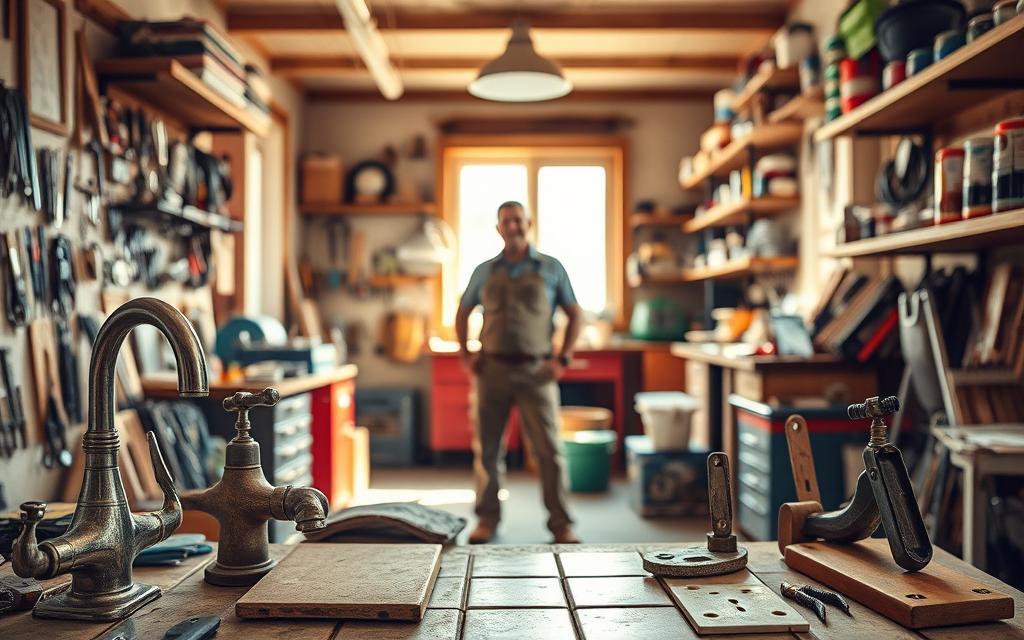As a dedicated homeowner, I know the value of DIY home repairs. With the right tools and knowledge, simple repairs can become easy tasks. In this article, I’ll share key tips to help you improve your home. We’ll cover fixing leaks and basic drywall repairs.
My aim is to give you the confidence to handle home maintenance on your own. This advice will help you feel more independent in keeping your home in top shape.
Key Takeaways
- Having the right tools is essential for effective DIY home repairs.
- Simple home repair tips can save time and money on maintenance.
- Regular preventative maintenance can prolong the life of your home.
- Mastering basic repair techniques empowers homeowners.
- Easy home improvement projects enhance the value of your property.
- Informed decision-making is key for successful repairs.
Essential Tools Every Homeowner Should Have
To start any home repair, having a good toolkit is key. A well-stocked set of tools helps me work faster and better. I choose tools that last long and work well.
My Must-Have Tools for Basic Repairs
The most important essential DIY tools are:
- Hammers and screwdrivers for putting things together.
- Pliers and wrenches for tightening things.
- Measuring tapes and levels for getting things right.
- Utility knives and sandpaper for cutting and smoothing.
Having these tools ready helps me tackle DIY projects well.
Budget-Friendly Options for Toolkits
Building a toolkit doesn’t have to cost a lot. I look for starter sets that have all the essential DIY tools. Brands like Craftsman and Stanley offer good tools at good prices. I also watch for sales or buy used tools to save money.
Where to Store Your Tools Efficiently
Keeping tools organized is important for smooth projects. I use different tool storage solutions to keep things tidy. Pegboards and shelves help me hang and store tools. Portable toolboxes make it easy to carry what I need.
Clear plastic bins are great for organizing DIY tools and keeping small parts in sight. Having everything I need close by makes repairs less stressful.
Common Home Repairs I Can Handle
Fixing common repairs at home makes me feel proud and saves money. I’ve learned to handle issues like leaky faucets and drywall problems. These DIY projects improve my skills and make my home better.
Fixing Leaky Faucets in Minutes
Leaky faucets are a big annoyance. To fix one, I first turn off the water to avoid flooding. Then, I take apart the faucet handle to check the washer or O-ring for damage.
If it’s damaged, I replace it. After reassembling, I check for leaks. This fix not only saves water but also cuts down on my water bill.
Simple Drywall Repair Techniques
Fixing drywall is easy with the right tools. For holes or dents, I start by cleaning the area. Then, I apply a drywall patch or joint compound with a putty knife.
Once it dries, I sand it lightly and paint it to match the wall. These repairs are simple and can be part of my home improvement projects.
How to Unclog Drains Effectively
Clogged drains can be a real problem. I use a mix of baking soda and vinegar to clean them. I pour half a cup of baking soda and half a cup of vinegar into the drain.
After a 30-minute wait for the fizzing to stop, I flush with hot water. This method is effective and saves money compared to chemical cleaners.
Preventative Maintenance Tips for My Home
To keep my home in top shape, I stick to regular preventive maintenance. I do home inspections often to spot problems early. This way, I avoid expensive fixes later.
Checking big systems like plumbing, electrical, and roofing twice a year is key. It helps me catch small issues before they grow. This saves time and gives me peace of mind.
Regular Checks to Avoid Headaches
I pay extra attention to areas that often have problems, like leaks or electrical issues. Simple checks can really help. They prevent bigger problems later.
Having a seasonal maintenance checklist helps me stay on track. I set reminders for different inspections throughout the year. This keeps my home running well.
Seasonal Maintenance Checklist
In spring, I clean gutters and check the air conditioning. This gets me ready for warmer weather. Summer is for lawn care and pest checks.
As fall comes, I prepare my heating system and check for drafts. Winter is for inspecting insulation and water pipes to prevent freezing. This routine keeps my home in good shape.
How to Keep My Home Energy Efficient
Improving energy efficiency is part of my plan. I add insulation and seal gaps to keep warmth in. Using curtains wisely also helps.
Changing air filters regularly keeps my HVAC system running well. Using energy-efficient appliances also helps save energy. This saves money and is good for the planet.



